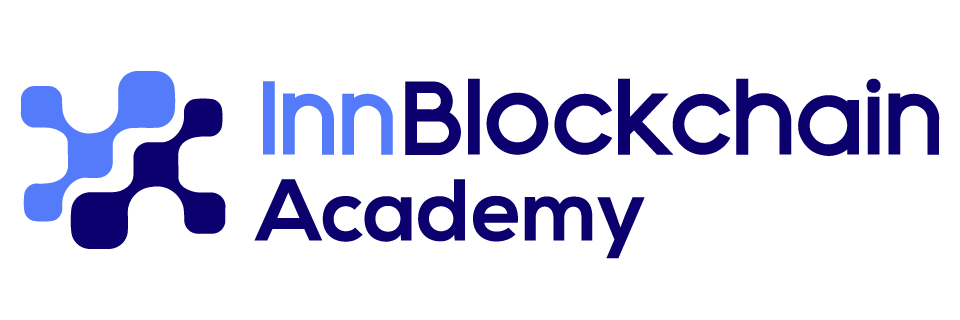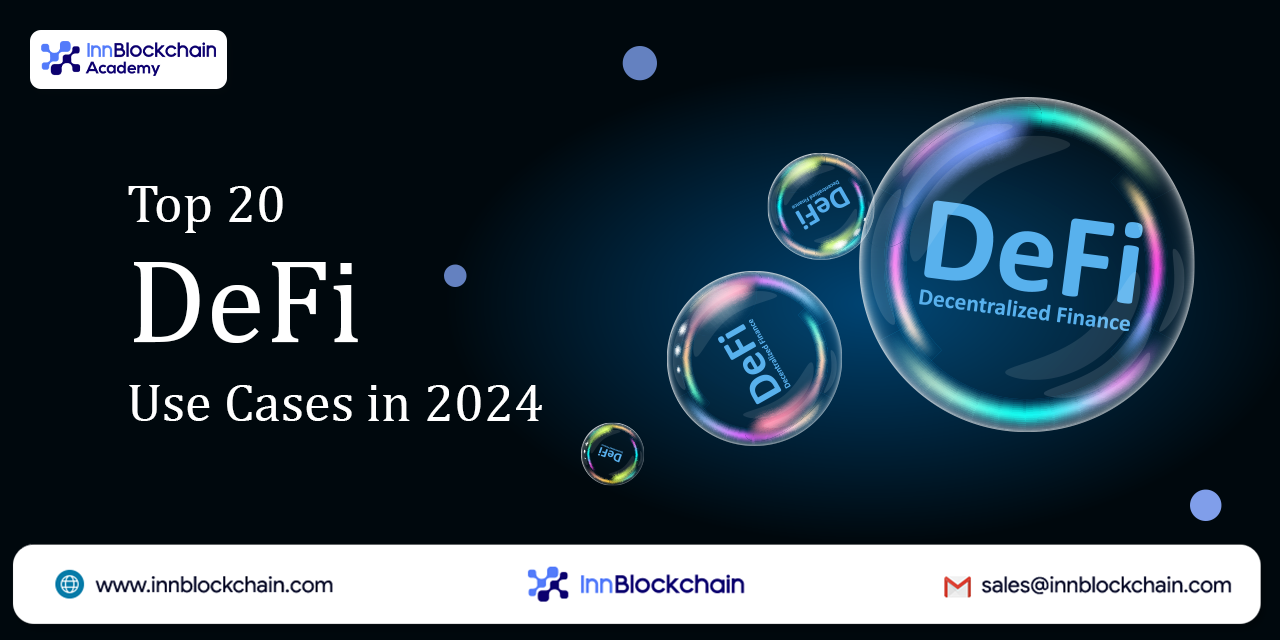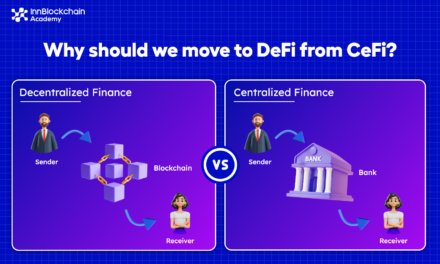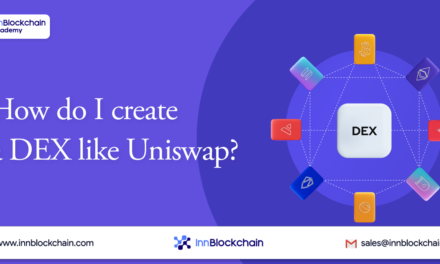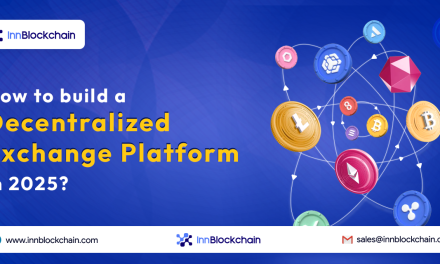Introduction
DeFi use cases highlight the diversity and potential of the DeFi ecosystem, which continues to evolve and expand as blockchain technology matures. To know more, let’s peep deeper into it.
The DeFi industry has the ability to replace the TradFi industry by utilizing blockchain-based applications and services to imitate banking, investing, and trading activities. Already, most of the TraFi services have a DeFi counterpart, and some are on the way.
DeFi is likely to provide any financial services, whether it may be exchanges, insurance, or staking solutions. The Defi concept is applied to several verticals daily. Here, let’s see about the top 20 DeFi use cases.
Major DeFi Use Cases
From innovative asset management to risk analysis, Defi is overflowing with numerous use cases that have the ability to reshape the future of finance. In this section, you can explore the topmost Defi use cases and their valuable market takeaways.
Borrowing and Lending
DeFi borrowing and lending are the most broadly utilized applications of the DeFi ecosystem. The DeFi platform allows users to lend their assets to others in exchange for interest. In turn, borrowers offer collateral in the form of other assets. Thus enabling p2p lending and borrowing. The borrowing and repayment processes are automatically managed by smart contracts. The uniqueness is that users can access loans without undergoing much paperwork like traditional finance.
Pool and Compound are the most famous DeFi platforms for lending & borrowing. It includes
- Quick transaction settlement
- Allows you to back up digital assets with real-life assets.
- Dont requires a credit score; instead, it offers access to all users.
Asset Management
The beneficial impact of DeFi is that users have complete control and ownership of their own assets. DeFi facilitates the users to manage their assets by buying, selling, lending, or earning interest.
By leveraging smart contracts and decentralized protocols, investors can automate investment strategies and rebalance portfolios without intermediaries. This means there is no need to share any personal data or information on the Defi platform, and also allows users to maintain their own accounts with a private key. In this way, Defi provides a more accessible & transparent way to control and manage assets, potentially democratizing financial management for a broader audience.
Identity Management
Another area where the DeFi development company reaps the advantages of DeFi is identity management. The DeFi protocols paired with an identity system backed by blockchain have the ability to assist locked-out users in attaining access to an entirely global economic system. Moreover, DeFi helps reduce the collateralization needs of individuals who lack funds. Beyond this, DeFi helps to enhance user’s creditworthiness via parameters like reputation and financial activity rather than income, home ownership, etc.
Insurance
Insurance is the most important financial business and one of the most popular DeFi use cases to date. Leveraging blockchain technology and smart contracts, a few insurance options have emerged to assist clients in receiving coverage and safeguarding their investments without the help of intermediaries like insurance companies. Despite hurdles, DeFi has evolved as a frontier in the insurance industry with the ability to redefine businesses and safeguard user’s assets in a decentralized and transparent manner.
Predictive Markets
This is something different; it is performed by betting on something that may or may not happen in the future. This includes the on-chain, insurance, and prediction markets, which are completely automated. These protocols are used to ensure bugs in smart contracts. On prediction-based platforms, users’ trade value depends on the outcome of future events. DeFi automates such types of transactions and also provides global access. DeFi projects like Augur facilitate users to place bets on events like gaming, sports, etc.
Stablecoins
Another prominent use case of DeFi is stablecoins, which are pegged to any kind of asset like Fiat, Gold, Oil, Commodities, or any other cryptocurrency. This stablecoin is necessary for DeFi applications to maintain a stable value and reduce cryptocurrency price volatility. Moreover, stablecoin acts as a medium of exchange for transactions and investments. The DeFi ecosystem includes stablecoins for remittance payments, lending, and borrowing platforms.
Some of the various types of stablecoins in the Defi space are fiat-backed stablecoins, algorithmic stablecoins, and collateralized stablecoins. Some of the most popular stablecoins include USDT, DAI, BUSD, and USDC.
DEXs
DEXs are the platform where users can transact in a p2p manner. It is simple, has no KYC, high speed, non-custodial, and low cost. This makes the users not depend on third-party exchanges. Moreover, with DEX users can easily connect via a Web3-enabled browser or DApp. Even though new users can trade independently by connecting their wallets to the platform without any complications. By connecting the wallet, you can simply exchange cryptos.
As the traders Once you connect to the platform with your wallet, you can exchange cryptos. Since users trade from their wallets by interacting with smart contracts, market manipulation, hacking, and theft are reduced. The largest DEX is Uniswap, which processes transactions worth more than $1 billion each day.
Infrastructure Equipment
In the DeFi ecosystem, composability is one of the most important features that work as an infrastructure development protocol via which several system components might interact, connect, and interoperate with one another easily. Infrastructure tools are the most prominent Defi use cases, as Defi projects are integrated via network effect The best examples of this use case are TruffleSuite and InfuraAPI.
Nowadays, people relate DeFi development to constructing with Legos. Thanks to Infura’s API suite, Truffle’s smart contract, and Diligence’s security tools, which help to construct & deploy Defi protocols with security integration as per the investor’s requirements.
DAOs
It is equivalent to centralized financial institutions in DeFi, which is one of the cornerstones of DeFi use cases. DAOs are decentralized bodies that utilize blockchain technology and smart contracts for automatic decision-making. DAOs are governed by code rather than a central authority. They resolve issues like corruption by maintaining a higher level of transparency where all the bylaws and criteria for decision-making are coded into smart contracts. DAOs could range from managing funds for projects to deciding on high-level projects like protocol upgrades
Compliance and KYC/AML
KYT, KYC, AML, and CFT compliance are integral to maintaining the integrity of financial systems. These compliances are especially followed to prevent money laundering and financial terrorism activities. But on the DeFi platform, more attention should be given to maintaining anonymity. Moreover, DeFi innovates in this domain by implementing blockchain-based transaction monitoring, identity verification, and risk assessment mechanisms.
In the conventional banking system, following KYC procedures is entirely stressed. Yet, the company’s most necessary compliance tool for executing AML and CFT procedures is the KYC regulation. But KYC regulation contradicts DeFi’s privacy attempts. To tackle this issue, DeFi uses the KYT technique, a more contemporary concept. This states that DeFi would care more about transaction behavior and digital addresses than user identities.
Staking
It is an attractive way to earn passive income in the cryptocurrency space. Staking in Defi is the process of locking up cryptos into smart contracts in exchange for rewards. It is the best way for cryptopreneurs to preserve their assets where they can also earn high interest. Defi staking is more attractive among users who can benefit from higher rewards than traditional accounts. It is a way for users to take part in network governance, secure the network, and acquire incentives in the form of additional tokens. Meanwhile, DeFi staking encourages the long-term participation of users in the blockchain, which ultimately increases the liquidity of the DeFi platform.
Yield Farming
The term yield farming has attained huge popularity in the DeFi blockchain development space. This is also called liquidity mining. It involves providing liquidity to the DeFi platform in exchange for rewards, typically in the form of cryptocurrency tokens. Under yield farming, users can easily lock up their digital assets on the platform, where they can, in turn, get rewards.
Mostly, yield farming allows users to earn passive income by lending or staking their assets on Defi platforms; this in turn helps Defi protocols maintain sufficient liquidity. This practice creates positive impacts among the users, as they can earn rewards for taking part in the network’s activity. This innovative mechanism of Defi changes the way we view liquidity provisioning and investment.
MLM
MLM is a unique method for incentivizing user participation and network growth within blockchain-based financial platforms. In this model, users earn rewards in the form of tokens not only for their activity but also for the activity performed by downline users. Smart contracts play a central role by automating reward distribution, ensuring transparency, and eliminating the need for centralized intermediaries. This integration can enhance user engagement and network effects, as individuals have a financial stake in growing the platform.
However, it’s essential to exercise caution and adhere to regulatory compliance, as MLM structures have faced scrutiny in the past. Transparency, fairness, and the avoidance of pyramid-like schemes are crucial principles when implementing DeFi with MLM to ensure the sustainability and trustworthiness of the ecosystem. Additionally, decentralized governance mechanisms can empower token holders to collectively make decisions about the MLM structure and reward distribution, enhancing community participation and control.
IDO
It is one of the important user cases of the DeFi ecosystem. IDO serves as a decentralized fundraising mechanism for blockchain projects, facilitating them to launch and distribute their tokens directly to a global audience via DEXs like Uniswap. This method democratizes access to early-stage investments and allows investors to take part in DEX until they have access.
IDO is characterized by its transparency, as all transactions are recorded on the blockchain, which minimizes the risk of fraudulent activities. Furthermore, they encourage community engagement by motivating investors to be part of the initial token distribution, which leads to an active and loyal user base.
STO
STO in the DeFi landscape combines the benefits of traditional securities with the benefits of blockchain technology. These offerings involve the distribution of security tokens, which are digital representations of real-world assets like bonds, real estate, stocks, etc.
STO bridges the gap between the traditional financial system and the DeFi ecosystem, offering an avenue for tokenizing and trading real-world assets on the DeFi platform while ensuring regulatory compliance. STO has the ability to unlock liquidity for illiquid assets, enhance accessibility for a global investor base, and streamline the investment process, making it a noteworthy development in the Defi ecosystem with prominent implications for traditional finance.
Interoperability
Interoperability is one of the critical Defi use cases addressing one of the industry’s most pressing challenges. Defi incorporates multiple blockchain platforms and protocols with its unique features. Interoperability connects these diverse ecosystems, allowing seamless communication and value transfer between different blockchains.
This improves liquidity by allowing assets to move freely between different DeFi platforms, thus increasing efficiency. Interoperability contributes to decentralization by minimizing the dominance of any single blockchain, making the Defi platform more resilient and inclusive.
Lottery
Lottery is one of the innovative Defi use cases leveraging blockchain technology to create transparent, provably fair, and decentralized games of chance. The lottery domain has offered various money-making opportunities for investors and users since its inception. Globally, the domain has attained significant traction as a result of these opportunities. The lottery has grown over time from serving offline to serving via digital platforms.
DeFi automates all lottery processes, from ticket sales to prize distribution, with the help of blockchain technology. Moreover, it removes fraud or any illegitimate activities by improving security and transparency. The blockchain’s non-tampering and decentralization characteristics, de-trust, and automatic execution of smart contracts provide hassle-free information sharing and real-time supervision, enhance transparency, and provide credible results.
Takeaway
Decentralized Finance Technology is a wider term that can’t be confined to the above-listed Defi use cases but has numerous domains where its ability can be implemented.
Nowadays, DeFi development has become mainstream, thus capturing global entrepreneurs’ attention. Stepping into the DeFi landscape at this moment is a wise choice for raising DeFi enthusiasts, as this domain is thriving at a greater pace.
Prior to getting started, it’s most important to search for a professional DeFi development company who can assist you from scratch and also help you set a position in the market. We a professional DeFi development company, have delivered numerous successful DeFi projects across the world. To get started, connect with our experts.
